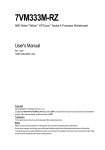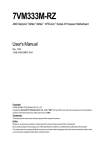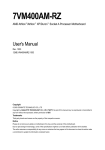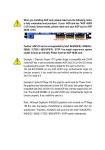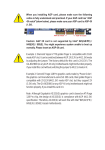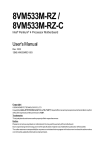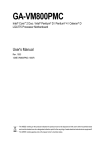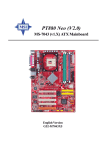Download Gigabyte 7VM400M-RZ Computer Hardware User Manual
Transcript
7VM400M-RZ
AMD Sempron™/Athlon™/Athlon™ XP/Duron™ Socket A Processor Motherboard
User's Manual
Rev. 1005
12ME-VM400MRZ-1005
Copyright
© 2005 GIGABYTE TECHNOLOGY CO., LTD
Copyright by GIGA-BYTE TECHNOLOGY CO., LTD. ("GBT"). No part of this manual may be reproduced or transmitted in
any from without the expressed, written permission of GBT.
Trademarks
Third-party brands and names are the property of their respective owners.
Notice
Please do not remove any labels on motherboard, this may void the warranty of this motherboard.
Due to rapid change in technology, some of the specifications might be out of date before publication of this booklet.
The author assumes no responsibility for any errors or omissions that may appear in this document nor does the author make
a commitment to update the information contained herein.
Mother Board
7VM400M-RZ
Feb. 20, 2004
Motherboard
7VM400M-RZ
Feb. 20 ,2004
Preparing Your Computer
Computer motherboards and expansion cards contain very delicate Integrated Circuit (IC) chips.
To protect them against damage from static electricity, you should follow some precautions whenever you work on your computer.
1. Unplug your computer when working on the inside.
2. Use a grounded wrist strap before handling computer components. If you do not have one,
touch both of your hands to a safely grounded object or to a metal object, such as the
power supply case.
3. Hold components by the edges and try not touch the IC chips, leads or connectors, or
other components.
4. Place components on a grounded antistatic pad or on the bag that came with the components whenever the components are separated from the system.
5. Ensure that the ATX power supply is switched off before you plug in or remove the ATX
power connector on the motherboard.
Installing the motherboard to the chassis
If the motherboard has mounting holes, but they don't line up with the holes on the base and
there are no slots to attach the spacers, do not become alarmed you can still attach the spacers to
the mounting holes. Just cut the bottom portion of the spacers (the spacer may be a little hard to
cut off, so be careful of your hands). In this way you can still attach the motherboard to the base
without worrying about short circuits. Sometimes you may need to use the plastic springs to isolate the screw from the motherboard PCB surface, because the circuit wire may be near by the
hole. Be careful, don't let the screw contact any printed circuit write or parts on the PCB that are
near the fixing hole, otherwise it may damage the board or cause board malfunctioning.
English
Table of Contents
Chapter 1 Introduction ................................................................................................. 5
Features Summary ................................................................................................................. 5
7VM400M-RZ Motherboard Layout ........................................................................................ 6
Block Diagram ........................................................................................................................ 7
Hardware Installation Process ................................................................................................ 8
Step 1: Set System Jumper (JP1) .......................................................................................... 8
Step 2: Install the Central Processing Unit (CPU) ................................................................. 9
Step 2-1: CPU Installation ........................................................................................................... 9
Step 2-2: CPU Cooling Fan Installation ...................................................................................... 9
Step 3: Install Memory Modules ........................................................................................... 10
Step 4: Install AGP Card ....................................................................................................... 11
Step 5: Install I/O Peripherals Cabels .................................................................................. 11
Step 5-1: I/O Back Panel Introduction ....................................................................................... 11
Step 5-2: Connectors Introduction ............................................................................................. 12
Chapter 2 BIOS Setup ............................................................................................... 19
The Main Menu (For example: BIOS Ver. : F5) .................................................................... 19
Standard CMOS Features .................................................................................................... 21
Advanced BIOS Features ..................................................................................................... 23
Integrated Peripherals .......................................................................................................... 24
Power Management Setup ................................................................................................... 26
PnP/PCI Configurations ........................................................................................................ 27
PC Health Status .................................................................................................................. 28
Frequency/Voltage Control ................................................................................................... 29
Load Fail-Safe Defaults ........................................................................................................ 30
Load Optimized Defaults ...................................................................................................... 30
Set Supervisor/User Password ............................................................................................. 31
Save & Exit Setup ................................................................................................................. 32
Exit Without Saving .............................................................................................................. 32
Chapter 3 Driver Installation....................................................................................... 33
7VM400M-RZ Motherboard
-4-
Features Summary
CPU
Chipset
Memory
Slots
On-Board IDE
On-Board Floppy
On-Board Peripherals
On-Board VGA
On-Board LAN
On-Board Sound
BIOS
I/O Control
Hardware Monitor
Additional Features
Overclocking
Form Factor
y
y
y
y
y
y
y
y
y
y
y
y
y
y
y
y
y
y
y
y
y
y
y
y
y
y
y
y
y
y
y
y
y
y
y
y
y
y
y
Socket A for AMD Sempron ™ / Athlon™ XP / Athlon™ / Duron™ processor
200/266/333MHz FSB
Supports 1.4GHz and faster
Northbridge : VIA KM400
Southbridge : VIA VT8235 / VT8237R
2 184-pin DDR DIMM sockets, supports up to 2GB DRAM (Max)
Supports DDR333/DDR266/DDR200 DIMM
Supports only 2.5V DDR SDRAM
1 AGP slot supports 8X/4X(1.5V) mode
3 PCI slots support 33MHz & PCI 2.2 compliant
2 IDE controller provide IDE HDD/CD-ROM(IDE1, IDE2) with PIO, Bus
Master (Ultra DMA33/ATA66/ATA100/ATA133) operation modes
Can connect up to 4 IDE devices
1 Floppy port supports 2 FDD with 360K, 720K,1.2M, 1.44M and 2.88M bytes
1 Parallel port supports Normal/EPP/ECP mode
1 Serial port (COMA), 1 VGA port, COMB on-board
6 USB 2.0/1.1 ports (2 x Rear, 4 x Front by cable)
1 Front Audio connector
1 PS/2 Keyboard
1 PS/2 Mouse
Built-in VIA KM400
Builit-in VIA VT6103 chipset
1 RJ45 port
VIA VT1617
Supports 2/4/6-channel
Line Out / Line In / Mic In
SPDIF Out
CD In / Game connector
Licensed AWARD BIOS
Supports Q-Flash™
ITE8705
CPU/System fan revolution detect
CPU/System temperature detect
System voltage detect
CPU/System fan fail warning
Supports @BIOS™
Supports EasyTune
Over clock (CPU/DDR) by BIOS
Over voltage (DDR/AGP) br BIOS
Micro ATX size form factor, 24.4cm x 22.3cm
-5-
Introduction
English
Chapter 1 Introduction
22.3 cm
KB_MS
LPT
COMA
ATX
FDD
CPU_FAN
IDE1
AGP 8X
SYS_FAN
AGP
VT6103
PCI1
PCI2
CD_IN
PCI3
CODEC
SUR_CEN
7VM400M-RZ Motherboard
COMB
-6-
CLR_CMOS
VIA
VT8235 /
VT8237R
BAT
F_USB1 F_USB2 PWR_LED
GAME
SPDIF
JP1
DDR2
BIOS
DDR1
F_AUDIO
F_PANEL
IDE2
LAN
LINE_IN
MIC_IN
USB
VIA KM400
IT8705
24.4 cm
7VM400M-RZ
VGA
SOCKET A
LINE_OUT
English
7VM400M-RZ Motherboard Layout
AMD-K7TM
Host CPU
AGP 4X/8X
System Bus
200/266/333MHz FSB
VGA Port
VIA
KM400
200/266/333MHz
DDR
HCLK+/- (100/133/166MHz)
NBGCLK66 MHz
VT6103
66MHz V_Link
RJ45
AGPCLK
66MHz
3 PCI
CPUCLK+/- (100/133/166MHz)
48 MHz
33 MHz
14.318 MHz
BIOS
PCI BUS 33MHz
VIA
VT8235 /
VT8237R
Game Port
LPC BUS
Floppy
IT8705
AC97 Link
LPT Port
24 MHz
PCICLK (33MHz)
USBCLK (48MHz)
14.318 MHz
33 MHz
ATA33/66/
100/133
IDE Channels
6 USB
Ports
33 MHz
PS/2 KB/Mouse
LINE-OUT
PCICLK
(33MHz)
MIC
LINE-IN
6 Channel
CODEC
2 COM Ports
CLK
GEN
-7-
HCLK+/- (100/133/166MHz)
CPUCLK+/- (100/133/166MHz)
AGPCLK (66MHz)
V_Link (66MHz)
Introduction
English
Block Diagram
English
Hardware Installation Process
To set up your computer, you must complete the following steps:
Step 1- Set System Jumper (JP1)
Step 2- Install the Central Processing Unit (CPU)
Step 3- Install Memory Modules
Step 4- Install Expansion Cards
Step 5- Install I/O Peripherals Cables
Step 3
Step 2
Step 5
Step 5
Step 4
Step 1
Step 1: Set System Jumper (JP1)
The system bus frequency can be switched at 100/133/166MHz by adjusting system jumper (JP1).
(The internal frequency depend on CPU.)
Short: 100MHz
1
Open: 133/166MHz
1
100MHz : Fix FSB 200MHz CPU
133/166MHz : Supports FSB 266/333MHz CPU
If you want to use a CPU with 200MHz FSB,
please set JP1 to 100MHz.
JP1
7VM400M-RZ Motherboard
-8-
Before installing the processor, adhere to the following warning:
1. Please make sure the CPU type is supported by the motherboard.
2. The processor will overheat without the heatsink and/or fan, resulting in permanent
irreparable damage.
3. If you do not match the CPU socket Pin 1 and CPU cut edge well, it will cause improper
installation. Please change the insert orientation.
4. Apply thermal grease between the processor and cooling fan.
5. Never run the processor without the heatsink properly and firmly attached. Permanent damage
will result.
6. Please set the CPU host frequency in accordance with your processor's specifications.
We don't recommend you to set the system bus frequency over the CPU's specification
because these specific bus frequencies are not the standard specifications for CPU, chipset
and most of the peripherals. Whether your system can run under these specific bus frequencies
properly will depend on your hardware configurations, including CPU, Memory, Cards…etc.
Step 2-1: CPU Installation
Socket Actuation Lever
Figure 1.
Pull the rod to the 90-degree
directly.
Figure 2.
Locate Pin 1 in the socket and look
for a cut edge on the CPU upper
corner. Insert the CPU into the
socket. (Do not force the CPU into the socket.) Then move the socket
lever to the locked position while holding pressure on the center of the
CPU.
Step 2-2: CPU Cooling Fan Installation
Figure 1.
Apply the thermal tape(or grease)
to provide better heat conduction
between your CPU and cooling
fan.
Figure 2.
Fasten the cooling fan supporting-base onto the CPU socket on
the motherboard.
-9-
Figure 3.
Make sure the CPU fan is plugged
to the CPU fan connector, than the
install completely.
Hardware Installation Process
English
Step 2: Install the Central Processing Unit (CPU)
English
Step 3: Install Memory Modules
Before installing the memory modules, adhere to the following warning:
1. Please note that the DIMM module can only fit in one direction due to the one notch. Wrong
orientation will cause improper installation. Please change the insert orientation.
The motherboard has 2 dual inline memory module (DIMM) sockets. The BIOS will automatically detects
memory type and size. To install the memory module, just push it vertically into the DIMM socket. The DIMM
module can only fit in one direction due to the notch. Memory size can vary between sockets.
Notch
DDR
1. The DIMM socket has a notch, so the DIMM memory
module can only fit in one direction.
2. Insert the DIMM memory module vertically into the
DIMM socket. Then push it down.
3. Close the plastic clip at both edges of the DIMM
sockets to lock the DIMM module.
Reverse the installation steps when you wish to remove the DIMM module.
7VM400M-RZ Motherboard
- 10 -
AGP 4X/8X notch
3. Please carefully pull out the small white-drawable bar at the end of the AGP slot when you try to install/
uninstall the AGP card. Please align the AGP card to the onboard AGP slot and press firmly down on the
slot. Make sure your AGP card is locked by the small white-drawable bar.
Step 5: Install I/O Peripherals Cables
Step 5-1: I/O Back Panel Introduction
X
\
Y
[
Z
^
_
]
`
X PS/2 Keyboard and PS/2 Mouse connector
This connector supports standard PS/2 keyboard and PS/2 mouse.
Y Parallel port (LPT)
Device like printer can be connected to Parallel port.
Z Serial port (COMA)
Mouse and modem etc. can be connected to Serial port.
[ VGA port
Monitor can be connected to VGA port.
\ LAN port
LAN is fast Ethernet with 10/100Mbps speed.
] USB port
Before you connect your device(s) into USB connector(s), please make sure your device(s) such as USB
keyboard, mouse, scanner, zip, speaker...etc. Have a standard USB interface. Also make sure your OS
supports USB controller. If your OS does not support USB controller, please contact OS vendor for
possible patch or driver upgrade. For more information please contact your OS or device(s) vendors.
^ Line In jack
Devices like CD-ROM, walkman etc. can be connected to Line In jack.
- 11 -
Hardware Installation Process
English
Step 4: Install AGP Card
1. Read the relate AGP card's instruction document before install the AGP card into the computer.
2. If your AGP card has "AGP 4X/8X(1.5V) notch"(show below), please make sure your AGP card is AGP
4X/8X(1.5V).
English
_ Line Out jack
Connect the stereo speakers or earphone to this connector.
` MIC In jack
Microphone can be connect to MIC In jack.
After installation of the audio driver, you are able to use 2/4/6-channel audio feature by software selection.
You can connect "Front speaker" to "Line Out" jack, Connect "Rear speaker" to "Line In" jack and connect "Center/Subwoofer" to "MIC In" jack.
Step 5-2: Connectors Introduction
2
1
4
5
8
3
15
11
16
9
10 12
1)
2)
3)
4)
5)
6)
7)
8)
13
ATX
CPU_FAN
SYS_FAN
FDD
IDE1 / IDE2
PWR_LED
F_PANEL
F_AUDIO
7VM400M-RZ Motherboard
14
9)
10)
11)
12)
13)
14)
15)
16)
- 12 -
6
7
SUR_CEN
SPDIF
CD_IN
COMB
GAME
F_USB1 / F_USB2
CLR_CMOS
BAT
AC power cord should only be connected to your power supply unit after ATX power cable and other
related devices are firmly connected to the mainboard.
11
20
1
Pin No.
Definition
Pin No.
Definition
1
2
3.3V
3.3V
11
12
3.3V
-12V
3
GND
13
GND
4
5
VCC
GND
14
15
PS_ON(soft on/off)
GND
6
VCC
16
GND
7
8
GND
Power Good
17
18
GND
-5V
9
5V SB (stand by +5V)
19
VCC
10
+12V
20
VCC
10
2) CPU_FAN (CPU Fan Connector)
Please note, a proper installation of the CPU cooler is essential to prevent the CPU from running under
abnormal condition or damaged by overheating. The CPU fan connector supports Max. current up to
600 mA.
Pin No.
1
Definition
1
2
GND
+12V
3
Sense
3) SYS_FAN (System Fan Connector)
This connector allows you to link with the cooling fan on the system case to lower the system temperature.
1
- 13 -
Pin No.
Definition
1
2
GND
+12V
3
Sense
Hardware Installation Process
English
1) ATX (ATX Power)
English
4) FDD (Floppy Connector)
Please connect the floppy drive ribbon cables to FDD. It supports 360K, 1.2M, 720K, 1.44M and
2.88M bytes floppy disk types.
The red stripe of the ribbon cable must be the same side with the Pin1.
34
33
2
1
5) IDE1 / IDE2 (IDE1 / IDE2 Connector)
Please connect first hard disk to IDE1 and connect CD-ROM to IDE2.
The red stripe of the ribbon cable must be the same side with the Pin1.
40
39
2
1
IDE1
IDE2
6) PWR_LED
PWR_LED is connect with the system power indicator to indicate whether the system is on/off.
It will blink when the system enters suspend mode.
1
7VM400M-RZ Motherboard
- 14 -
Pin No.
1
Definition
MPD+
2
3
MPDMPD-
Please connect the power LED, PC speaker, reset switch and power switch etc. of your chassis front
panel to the F_PANEL connector according to the pin assignment below.
SPEAK+
19 20
1
1
1
HD+
HDRESRES+
NC
1
1 2
1
Speaker Connector
SPEAK-
Power
Switch
MSG+
MSGPW+
PW-
Message LED/Power/
Sleep LED
IDE Hard Disk
Active LED
Reset Switch
HD (IDE Hard Disk Active LED)
Pin 1: LED anode(+)
SPK (Speaker Connector)
Pin 2: LED cathode(-)
Pin 1: VCC(+)
Pin 2- Pin 3: NC
Pin 4: Data(-)
RES (Reset Switch)
Open: Normal Operation
Close: Reset Hardware System
PW (Power Switch)
Open: Normal Operation
Close: Power On/Off
MSG (Message LED/ Power/ Sleep LED)
Pin 1: LED anode(+)
Pin 2: LED cathode(-)
NC
NC
8) F_AUDIO (Front Audio Connector)
If you want to use Front Audio connector, you must remove 5-6, 9-10 Jumper.
In order to utilize the front audio header, your chassis must have front audio connector. Also please
make sure the pin assigment on the cable is the same as the pin assigment on the MB header. To find
out if the chassis you are buying support front audio connector, please contact your dealer. Please note,
you can have the alternative of using front audio connector or of using rear audio connector to play
sound.
Pin No.
1 2
9 10
- 15 -
Definition
1
2
MIC
GND
3
4
MIC_BIAS
Power
5
6
Front Audio (R)
Rear Audio (R)
7
8
Reserved
No Pin
9
10
Front Audio (L)
Rear Audio (L)
Hardware Installation Process
English
7) F_PANEL (2 x 10 pins Connector)
English
9) SUR_CEN (Surround Center Connector)
Please contact your nearest dealer for optional SUR_CEN cable.
1
2
5
6
Pin No.
Definition
1
2
SUR OUTL
SUR OUTR
3
4
GND
No Pin
5
6
CENTER_OUT
BASS_OUT
10) SPDIF (SPDIF Out Connector)
The SPDIF output is capable of providing digital audio to external speakers or compressed AC3 data to
an external Dolby Digital Decoder. Use this feature only when your stereo system has digital input
function. Be careful with the polarity of the SPDIF connector. Check the pin assignment carefully while
you connect the SPDIF cable, incorrect connection between the cable and connector will make the
device unable to work or even damage it. For optional SPDIF cable, please contact your local dealer.
1 2
5 6
Pin No.
Definition
1
2
VCC
No Pin
3
4
SPDIF
NC
5
6
GND
GND
11) CD_IN (CD In Connector)
Connect CD-ROM or DVD-ROM audio out to the connector.
1
7VM400M-RZ Motherboard
- 16 -
Pin No.
1
Definition
CD-L
2
3
GND
GND
4
CD-R
Be careful with the polarity of the COMB connector. Check the pin assignment carefully while you
connect the COMB cable, incorrect connection between the cable and connector will make the device
unable to work or even damage it. For optional COMB cable, please contact your local dealer.
Pin No.
1
2
1
10
9
Definition
NDCDB-
2
3
NSINB
NSOUTB
4
5
NDTRBGND
6
7
NDSRBNRTSB-
8
9
NCTSBNRIB-
10
No Pin
13) GAME (Game Connector)
This connector supports joystick, MIDI keyboard and other relate audio devices. Check the pin assignment while you connect the game cables. Please contact your nearest dealer for optional game cables.
Pin No.
2
16
1
15
Definition
Pin No.
Definition
1
2
VCC
GRX1_R
9
10
GPSA1
GND
3
GND
11
GRY1_R
4
5
GPSA2
VCC
12
13
VCC
GPSB1
6
GRX2_R
14
MSO_R
7
8
GRY2_R
MSI_R
15
16
GPSB2
No Pin
14) F_USB1 / F_USB2 (Front USB Connector)
Be careful with the polarity of the front USB connector. Check the pin assignment carefully while you
connect the front USB cable, incorrect connection between the cable and connector will make the device unable to work or even damage it. For optional front USB cable, please contact your local dealer.
2
10
1
9
- 17 -
Pin No.
Definition
1
2
Power
Power
3
4
USB DxUSB Dy-
5
6
USB Dx+
USB Dy+
7
8
GND
GND
9
10
No Pin
NC
Hardware Installation Process
English
12) COMB (COM B Connector)
English
15) CLR_CMOS (Clear CMOS)
You may clear the CMOS data to its default values by this jumper. To clear CMOS, temporarily short
1-2 pin. Default doesn't include the "Shunter" to prevent from improper use this jumper.
Close: Clear CMOS
1
Open: Normal
1
16) BAT (Battery)
CAUTION
Danger of explosion if battery is incorrectly
replaced.
Replace only with the same or equivalent type
recommended by the manufacturer.
Dispose of used batteries according to the
manufacturer's instructions.
If you want to erase CMOS...
1. Turn OFF the computer and unplug the power cord.
2. Remove the battery, wait for 30 seconds.
3. Re-install the battery.
4. Plug the power cord and turn ON the computer.
7VM400M-RZ Motherboard
- 18 -
BIOS Setup is an overview of the BIOS Setup Program. The program that allows users to modify the
basic system configuration. This type of information is stored in battery-backed CMOS RAM so that it
retains the Setup information when the power is turned off.
ENTERING SETUP
Powering ON the computer and pressing <Del> immediately will allow you to enter Setup. If you require
more advanced BIOS settings, please go to "Advanced BIOS" setting menu. To enter Advanced BIOS
setting menu, press "Ctrl+F1" key on the BIOS screen.
CONTROL KEYS
< >< ><
<Enter>
<Esc>
><
<+/PgUp>
<-/PgDn>
<F1>
<F2>
<F5>
<F6>
<F7>
<F8>
<F9>
<F10>
>
Move to select item
Select Item
Main Menu - Quit and not save changes into CMOS Status Page Setup Menu
and Option Page Setup Menu - Exit current page and return to Main Menu
Increase the numeric value or make changes
Decrease the numeric value or make changes
General help, only for Status Page Setup Menu and Option Page Setup Menu
Item Help
Restore the previous CMOS value from CMOS, only for Option Page Setup Menu
Load the file-safe default CMOS value from BIOS default table
Load the Optimized Defaults
Q-Flash utility
System Information
Save all the CMOS changes, only for Main Menu
Main Menu
The on-line description of the highlighted setup function is displayed at the bottom of the screen.
Status Page Setup Menu / Option Page Setup Menu
Press F1 to pop up a small help window that describes the appropriate keys to use and the possible
selections for the highlighted item. To exit the Help Window press <Esc>.
The Main Menu (For example: BIOS Ver. : F5)
Once you enter Award BIOS CMOS Setup Utility, the Main Menu (as figure below) will appear on the
screen. The Main Menu allows you to select from eight setup functions and two exit choices. Use
arrow keys to select among the items and press <Enter> to accept or enter the sub-menu.
CMOS Setup Utility-Copyright (C) 1984-2004 Award Software
`
`
`
`
`
`
`
Standard CMOS Features
Advanced BIOS Features
Integrated Peripherals
Power Management Setup
PnP/PCI Configurations
PC Health Status
Frequency/Voltage Control
Load Fail-Safe Defaults
Load Optimized Defaults
Set Supervisor Password
Set User Password
Save & Exit Setup
Exit Without Saving
KLJI: Select Item
F10: Save & Exit Setup
ESC: Quit
F8: Q-Flash
Time, Date, Hard Disk Type...
- 19 -
BIOS Setup
English
Chapter 2 BIOS Setup
English
If you can't find the setting you want, please press "Ctrl+F1" to search the advanced
option hidden.
• Standard CMOS Features
This setup page includes all the items in standard compatible BIOS.
• Advanced BIOS Features
This setup page includes all the items of Award special enhanced features.
• Integrated Peripherals
This setup page includes all onboard peripherals.
• Power Management Setup
This setup page includes all the items of Green function features.
• PnP/PCI Configuration
This setup page includes all the configurations of PCI & PnP ISA resources.
• PC Health Status
This setup page is the System auto detect Temperature, voltage, fan, speed.
• Frequency/Voltage Control
This setup page is control CPU clock and frequency ratio.
• Load Fail-Safe Defaults
Fail-Safe Defaults indicates the value of the system parameters which the system would be in safe
configuration.
• Load Optimized Defaults
Optimized Defaults indicates the value of the system parameters which the system would be in
best performance configuration.
• Set Supervisor Password
Change, set, or disable password. It allows you to limit access to the system and Setup, or just
to Setup.
• Set User Password
Change, set, or disable password. It allows you to limit access to the system.
• Save & Exit Setup
Save CMOS value settings to CMOS and exit setup.
• Exit Without Saving
Abandon all CMOS value changes and exit setup.
7VM400M-RZ Motherboard
- 20 -
CMOS Setup Utility-Copyright (C) 1984-2004 Award Software
Standard CMOS Features
`
`
`
`
Date (mm:dd:yy)
Time (hh:mm:ss)
Tue, Nov 2 2004
22:31:24
IDE
IDE
IDE
IDE
[None]
[None]
[None]
[None]
Primary Master
Primary Slave
Secondary Master
Secondary Slave
Drive A
Drive B
Floppy 3 Mode Suport
[1.44M, 3.5"]
[None]
[Disabled]
Halt On
[All, But Keyboard]
Base Memory
Extended Memory
Total Memory
640K
127M
128M
KLJI: Move
Enter: Select
F5: Previous Values
+/-/PU/PD: Value
F10: Save
F6: Fail-Safe Defaults
Item Help
Menu Level`
Change the day, month,
year
<Week>
Sun. to Sat.
<Month>
Jan. to Dec.
<Day>
1 to 31 (or maximum
allowed in the month)
<Year>
1999 to 2098
ESC: Exit
F1: General Help
F7: Optimized Defaults
Date
The date format
Week
Month
Day
Year
is <week>, <month>, <day>, <year>.
The week, from Sun to Sat, determined by the BIOS and is display only
The month, Jan. Through Dec.
The day, from 1 to 31 (or the maximum allowed in the month)
The year, from 1999 through 2098
Time
The times format in <hour> <minute> <second>. The time is calculated base on the 24-hour
military-time clock. For example, 1 p.m. is 13:00:00.
IDE Primary Master, Slave / IDE Secondary Master, Slave
The category identifies the types of hard disk from drive C to F that has been installed in the
computer. There are two types: auto type, and manual type. Manual type is user-definable; Auto type
which will automatically detect HDD type.
Note that the specifications of your drive must match with the drive table. The hard disk will not work
properly if you enter improper information for this category.
If you select User Type, related information will be asked to enter to the following items. Enter the information
directly from the keyboard and press <Enter>. Such information should be provided in the documentation form your hard disk vendor or the system manufacturer.
Cylinder
Number of cylinders
Head
Number of heads
Precomp
Write precomp
Landing Zone Landing zone
Sector
Number of sectors
If a hard disk has not been installed, select NONE and press <Enter>.
- 21 -
BIOS Setup
English
Standard CMOS Features
English
Drive A / Drive B
The category identifies the types of floppy disk drive A or drive B that has been installed in the
computer.
None
No floppy drive installed
360K, 5.25" 5.25 inch PC-type standard drive; 360K byte capacity.
1.2M, 5.25" 5.25 inch AT-type high-density drive; 1.2M byte capacity
(3.5 inch when 3 Mode is Enabled).
720K, 3.5"
3.5 inch double-sided drive; 720K byte capacity
1.44M, 3.5" 3.5 inch double-sided drive; 1.44M byte capacity.
2.88M, 3.5" 3.5 inch double-sided drive; 2.88M byte capacity.
Floppy 3 Mode Support (for Japan Area)
Disabled
Drive A
Drive B
Both
Normal Floppy Drive. (Default value)
Drive A is 3 mode Floppy Drive.
Drive B is 3 mode Floppy Drive.
Drive A & B are 3 mode Floppy Drives.
Halt on
The category determines whether the computer will stop if an error is detected during power up.
No Errors
The system boot will not stop for any error that may be detected and you
will be prompted.
All Errors
Whenever the BIOS detects a non-fatal error the system will be stopped.
All, But Keyboard The system boot will not stop for a keyboard error; it will stop for all other
errors. (Default value)
All, But Diskette
The system boot will not stop for a disk error; it will stop for all other errors.
All, But Disk/Key The system boot will not stop for a keyboard or disk error; it will stop for all
other errors.
Memory
The category is display-only which is determined by POST (Power On Self Test) of the BIOS.
Base Memory
The POST of the BIOS will determine the amount of base (or conventional) memory installed
in the system.
The value of the base memory is typically 512K for systems with 512K memory installed on
the motherboard, or 640K for systems with 640K or more memory installed on the motherboard.
Extended Memory
The BIOS determines how much extended memory is present during the POST.
This is the amount of memory located above 1 MB in the CPU's memory address map.
Total Memory
This item displays the memory size that used.
7VM400M-RZ Motherboard
- 22 -
CMOS Setup Utility-Copyright (C) 1984-2004 Award Software
Advanced BIOS Features
First Boot Device
Second Boot Device
Third Boot Device
Password Check
[Floppy]
[HDD-0]
[CDROM]
[Setup]
Item Help
Menu Level`
Select Boot Device
priority
[Floppy]
Boot from floppy
[LS120]
Boot from LS120
[HDD-0]
Boot from First HDD
[HDD-1]
Boot from Second HDD
KLJI: Move
Enter: Select
F5: Previous Values
+/-/PU/PD: Value
F10: Save
F6: Fail-Safe Defaults
ESC: Exit
F1: General Help
F7: Optimized Defaults
First / Second / Third Boot Device
Floppy
LS120
HDD-0~3
SCSI
CDROM
ZIP
USB-FDD
USB-ZIP
USB-CDROM
USB-HDD
LAN
Disabled
Select your boot device priority by Floppy.
Select your boot device priority by LS120.
Select your boot device priority by HDD-0~3.
Select your boot device priority by SCSI.
Select your boot device priority by CDROM.
Select your boot device priority by ZIP.
Select your boot device priority by USB-FDD.
Select your boot device priority by USB-ZIP.
Select your boot device priority by USB-CDROM.
Select your boot device priority by USB-HDD.
Select your boot device priority by LAN.
Select your boot device priority by Disabled.
Password Check
System
Setup
The system can not boot and can not access to Setup page will be denied if the
correct password is not entered at the prompt.
The system will boot, but access to Setup will be denied if the correct password
is not entered at the prompt. (Default value)
- 23 -
BIOS Setup
English
Advanced BIOS Features
English
Integrated Peripherals
CMOS Setup Utility-Copyright (C) 1984-2004 Award Software
Integrated Peripherals
OnChip IDE Channel0
OnChip IDE Channel1
AC97 Audio
VIA Onboard LAN
USB 1.1 Controller
USB 2.0 Controller
USB Keyboard Support
USB Mouse Support
On-Chip LAN Boot ROM
Onboard Serial Port 1
Onboard Serial Port 2
Onboard Parallel Port
Parallel Port Mode
Game Port Address
Midi Port Address
x Midi Port IRQ
KLJI: Move
Enter: Select
F5: Previous Values
[Enabled]
[Enabled]
[Auto]
[Enabled]
[Enabled]
[Enabled]
[Disabled]
[Disabled]
[Disabled]
[3F8/IRQ4]
[2F8/IRQ3]
[378/IRQ7]
[SPP]
[201]
[Disabled]
10
+/-/PU/PD: Value
F10: Save
F6: Fail-Safe Defaults
Item Help
Menu Level`
If a hard disk
controller card is
used, set at Disabled
[Enabled]
Enable onboard IDE
channel
[Disabled]
Disable onboard IDE
channel
ESC: Exit
F1: General Help
F7: Optimized Defaults
OnChip IDE Channel0
When set at "Enabled", it allows you to use the onboard primary PCI IDE. If a hard disk controller
card is used, please set at "Disabled".
Enabled
Enable onboard 1st channel IDE port. (Default value)
Disabled
Disable onboard 1st channel IDE port.
OnChip IDE Channel1
When set at "Enabled", it allows you to use the onboard secondary PCI IDE. If a hard disk controller
card is used, please set at "Disabled".
Enabled
Enable onboard 2nd channel IDE port. (Default value)
Disabled
Disable onboard 2nd channel IDE port.
AC97 Audio
Enabled
Disabled
Enable onboard AC'97 audio function. (Default value)
Disable this function.
VIA Onboard LAN
Enabled
Disabled
Enable onboard LAN function. (Default value)
Disable this function.
USB 1.1 Controller
Disable this function if you are not using the onboard USB feature.
Enabled
Enable USB 1.1 controller. (Default value)
Disabled
Disable USB 1.1 controller.
USB 2.0 Controller
Disable this function if you are not using the onboard USB feature.
Enabled
Enable USB 2.0 controller. (Default value)
Disabled
Disable USB 2.0 controller.
USB Keyboard Support
Enabled
Disabled
Enable USB keyboard support.
Disable USB keyboard support. (Default value)
7VM400M-RZ Motherboard
- 24 -
Enabled
Disabled
English
USB Mouse Support
Enable USB mouse support.
Disable USB mouse support. (Default value)
On-Chip LAN Boot ROM
This function decide whether to invoke the boot ROM of the onboard LAN chip.
Disabled
Disable this function. (Default Value)
Enabled
Enable this function.
Onboard Serial Port 1
Auto
3F8/IRQ4
2F8/IRQ3
3E8/IRQ4
2E8/IRQ3
Disabled
BIOS will automatically setup the port 1 address.
Enable onboard Serial port 1 and address is 3F8. (Default value)
Enable onboard Serial port 1 and address is 2F8.
Enable onboard Serial port 1 and address is 3E8.
Enable onboard Serial port 1 and address is 2E8.
Disable onboard Serial port 1.
Onboard Serial Port 2
Auto
3F8/IRQ4
2F8/IRQ3
3E8/IRQ4
2E8/IRQ3
Disabled
BIOS will automatically setup the port 2 address.
Enable onboard Serial port 2 and address is 3F8.
Enable onboard Serial port 2 and address is 2F8. (Default value)
Enable onboard Serial port 2 and address is 3E8.
Enable onboard Serial port 2 and address is 2E8.
Disable onboard Serial port 2.
Onboard Parallel port
This feature allows you to select from a given set of parameters if the parallel port uses the onboard
I/O controller.
378/IRQ7
Enable onboard LPT port and address is 378/IRQ7. (Default value)
278/IRQ5
Enable onboard LPT port and address is 278/IRQ5.
Disabled
Disable onboard LPT port.
3BC/IRQ7
Enable onboard LPT port and address is 3BC/IRQ7.
Parallel Port Mode
SPP
EPP
ECP
ECP+EPP
Using Parallel port as Standard Parallel Port. (Default value)
Using Parallel port as Enhanced Parallel Port.
Using Parallel port as Extended Capabilities Port.
Using Parallel port as ECP & EPP mode.
Game Port Address
201
209
Disabled
Set Game Port Address to 201. (Default value)
Set Game Port Address to 209.
Disable this function.
Midi Port Address
300
330
Disabled
Set Midi Port Address to 300.
Set Midi Port Address to 330.
Disable this function. (Default value)
Midi Port IRQ
5
10
Set Midi Port IRQ to 5.
Set Midi Port IRQ to 10. (Default value)
- 25 -
BIOS Setup
English
Power Management Setup
CMOS Setup Utility-Copyright (C) 1984-2004 Award Software
Power Management Setup
ACPI Suspend Type
x USB Device Wake-Up from S3
Power LED in S1 state
Soft-Off by PWRBTN
AC BACK Function
Keyboard Power On
Mouse Power On
PME Event Wake Up
ModemRingOn/WakeOnLan
Resume by Alarm
x Date (of Month) Alarm
x Time (hh:mm:ss) Alarm
KLJI: Move
Enter: Select
F5: Previous Values
[S1(POS)]
Disabled
[Blinking]
[Instant-Off]
[Soft-Off]
[Disabled]
[Disabled]
[Enabled]
[Enabled]
[Disabled]
Everyday
0 : 0 : 0
+/-/PU/PD: Value
F10: Save
F6: Fail-Safe Defaults
Item Help
Menu Level`
[S1]
Set suspend type to
Power On Suspend under
ACPI OS
[S3]
Set suspend type to
Suspend to RAM under
ACPI OS
ESC: Exit
F1: General Help
F7: Optimized Defaults
ACPI Suspend Type
S1(POS)
S3(STR)
Set ACPI suspend type to S1. (Default value)
Set ACPI suspend type to S3.
USB Device Wake-Up From S3
This function will available when "ACPI Suspend Type" set at "S3/STR".
Disabled
USB device can't wake up system from S3.
Enabled
USB device can wake up system from S3. (Default value)
Power LED in S1 state
Blinking
Dual/Off
In
In
a.
b.
standby mode(S1), power LED will blink. (Default value)
standby mode(S1):
If you use single color LED, power LED will ture off.
If you use dual color LED, power LED will ture to another color.
Soft-off by PWR-BTTN
Instant-off
Delay 4 Sec.
Press power button then Power off instantly. (Default value)
Press power button 4 sec to Power off. Enter suspend if button is pressed
less than 4 sec.
AC BACK Function
Soft-Off
Full-On
Memory
Always in Off state when AC back to the system. (Default value)
Always power on the system when AC back.
System power on depends on the status before AC lost.
Keyboard Power On
Disabled
Password
Keyboard 98
Disable this function. (Default value)
Enter from 1 to 5 characters to set the keyboard power on password.
If your keyboard has a "POWER Key" button, you can press the key to
power on your system.
Mouse Power On
Disabled
Enabled
7VM400M-RZ Motherboard
Disabled this function. (Default value)
Power on system by mouse event.
- 26 -
When set at Enabled, any PCI-PM event can awake the system from a PCI-PM controlled stated.
This feature requires an ATX power supply that provides at least 1A on the +5VSB lead.
Disabled
Disable this function.
Enabled
Enable PME as wake up event. (Default value)
ModemRingOn/WakeOnLan
An incoming call via modem or an input signal comes from the other client server on the LAN can
awake the system from any suspend state.
Disabled
Disable Modem Ring on function.
Enabled
Enable Modem Ring on function. (Default value)
Resume by Alarm
You can set "Resume by Alarm" item to enabled and key in Data/time to power on system.
Disabled
Disable this function. (Default Value)
Enabled
Enable alarm function to POWER ON system.
If RTC Alarm Lead To Power On is Enabled.
Date (of Month) Alarm :
Everyday, 1~31
Time (hh: mm: ss) Alarm :
(0~23) : (0~59) : (0~59)
KB Power ON Password
Enter
Input password (from 1 to 5 characters) and press Enter to set the keyboard
power on password.
PnP/PCI Configurations
CMOS Setup Utility-Copyright (C) 1984-2004 Award Software
PnP/PCI Configurations
PCI 1 IRQ Assignment
PCI 2 IRQ Assignment
PCI 3 IRQ Assignment
[Auto]
[Auto]
[Auto]
Item Help
Menu Level`
Device(s) using this
INT:
Display Cntrlr
-Bus 1 Dev 0 Func 0
KLJI: Move
Enter: Select
F5: Previous Values
+/-/PU/PD: Value
F10: Save
F6: Fail-Safe Defaults
ESC: Exit
F1: General Help
F7: Optimized Defaults
PCI 1 IRQ Assignment
Auto
3,4,5,7,9,10,11,12,14,15
Auto assign IRQ to PCI 1. (Default value)
Set IRQ 3,4,5,7,9,10,11,12,14,15 to PCI 1.
PCI 2 IRQ Assignment
Auto
3,4,5,7,9,10,11,12,14,15
Auto assign IRQ to PCI 2. (Default value)
Set IRQ 3,4,5,7,9,10,11,12,14,15 to PCI 2.
PCI 3 IRQ Assignment
Auto
3,4,5,7,9,10,11,12,14,15
Auto assign IRQ to PCI 3. (Default value)
Set IRQ 3,4,5,7,9,10,11,12,14,15 to PCI 3.
- 27 -
BIOS Setup
English
PME Event Wake Up
English
PC Health Status
CMOS Setup Utility-Copyright (C) 1984-2004 Award Software
PC Health Status
Vcore
25VSTR
+3.3V
+12V
Current System Temperature
Current CPU Temperature
Current CPU FAN Speed
Current SYSTEM FAN Speed
CPU FAN Fail Warning
SYSTEM FAN Fail Warning
KLJI: Move
Enter: Select
F5: Previous Values
OK
OK
OK
OK
32 oC
45 oC
4687 RPM
0 RPM
[Disabled]
[Disabled]
+/-/PU/PD: Value
F10: Save
F6: Fail-Safe Defaults
Current Voltage (V) Vcore / 25VSTR / +3.3V / +12V
Detect system's voltage status automatically.
Current System/CPU Temperature
Detect system/CPU temperature automatically.
Current CPU/SYSTEM FAN Speed (RPM)
Detect CPU/system Fan speed status automatically.
CPU FAN Fail Warning
Disabled
Enabled
Fan warning function disable. (Default value)
Fan warning function enable.
SYSTEM FAN Fail Warning
Disabled
Enabled
Fan warning function disable. (Default value)
Fan warning function enable.
7VM400M-RZ Motherboard
- 28 -
Item Help
Menu Level`
ESC: Exit
F1: General Help
F7: Optimized Defaults
CMOS Setup Utility-Copyright (C) 1984-2004 Award Software
Frequency/Voltage Control
Auto Detect PCI/DIMM Clk
Spread Specturm
CPU Host Clock Control
x CPU Clock
DRAM Clock(MHz)
AGP OverVoltage Control
DIMM OverVoltage Control
[Enabled]
[Enabled]
[Disabled]
133MHz
[By SPD]
[Auto]
[Auto]
KLJI: Move
Enter: Select
F5: Previous Values
+/-/PU/PD: Value
F10: Save
F6: Fail-Safe Defaults
Item Help
Menu Level`
ESC: Exit
F1: General Help
F7: Optimized Defaults
Incorrect using these features may cause your system broken. For power End-User use only!
Auto Detect PCI/DIMM Clk
Disabled
Enabled
Disable this function.
Auto detect PCI/DIMM clock. (Default value)
Spread Spectrum
Disabled
Enabled
Disable this function.
Enable clock spread spectrum. (Default value)
CPU Host Clock Control
Note: If system hangs up before enter CMOS setup utility, wait for 20 sec for times out reboot.
When time out occur, system will reset and run at CPU default Host clock at next boot.
Disabled
Disable CPU Host Clock Control. (Default value)
Enabled
Enable CPU Host Clock Control.
CPU Clock
133MHz ~ 165MHz
Set CPU Host Clock from 100MHz to 165MHz.
DRAM Clock (MHz)
Wrong frequency may make system can't boot, clear CMOS to overcome wrong frequency issue.
By SPD
Set memory frequency by DRAM SPD data. (Default value)
133-DDR266
If you use DDR266 DRAM module, please set at "133-DDR266".
166-DDR333
If you use DDR333 DRAM module, please set at "166-DDR333".
AGP OverVoltage Control
Increase AGP voltage may get stable for over-clock. But it may damage to AGP card when enable
this feature.
Auto
Supply voltage as AGP required. (Default value)
+0.1V
Increase AGP voltage +0.1V.
+0.2V
Increase AGP voltage +0.2V.
+0.3V
Increase AGP voltage +0.3V.
- 29 -
BIOS Setup
English
Frequency/Voltage Control
English
DIMM OverVoltage Control
Increase DIMM voltage may get stable for over-clock. But it may damage to memory module
when enable this feature.
Auto
Supply voltage as DIMM required. (Default value)
+0.1V
Increase DIMM voltage +0.1V.
+0.2V
Increase DIMM voltage +0.2V.
+0.3V
Increase DIMM voltage +0.3V.
Load Fail-Safe Defaults
CMOS Setup Utility-Copyright (C) 1984-2004 Award Software
`
`
`
`
`
`
`
Standard CMOS Features
Load Fail-Safe Defaults
Advanced BIOS Features
Load Optimized Defaults
Integrated Peripherals
Set Supervisor Password
Power Management Setup
Set User Password
PnP/PCI Configurations Load Fail-Safe Defaults
Save
(Y/N)?
& Exit
N Setup
PC Health Status
Exit Without Saving
Frequency/Voltage Control
KLJI: Select Item
F10: Save & Exit Setup
ESC: Quit
F8: Q-Flash
Load Fail-Safe Defaults
Fail-Safe defaults contain the most appropriate values of the system parameters that allow minimum
system performance.
Load Optimized Defaults
CMOS Setup Utility-Copyright (C) 1984-2004 Award Software
`
`
`
`
`
`
`
Standard CMOS Features
Load Fail-Safe Defaults
Advanced BIOS Features
Load Optimized Defaults
Integrated Peripherals
Set Supervisor Password
Power Management Setup
Set User Password
PnP/PCI Configurations Load Optimized Defaults
Save
(Y/N)?
& Exit
N Setup
PC Health Status
Exit Without Saving
Frequency/Voltage Control
KLJI: Select Item
F10: Save & Exit Setup
ESC: Quit
F8: Q-Flash
Load Optimized Defaults
Selecting this field loads the factory defaults for BIOS and Chipset Features which the system automatically
detects.
7VM400M-RZ Motherboard
- 30 -
English
Set Supervisor/User Password
CMOS Setup Utility-Copyright (C) 1984-2004 Award Software
`
`
`
`
`
`
`
Standard CMOS Features
Advanced BIOS Features
Integrated Peripherals
Power Management Setup
PnP/PCI Configurations
Enter Password:
PC Health Status
Frequency/Voltage Control
Load Fail-Safe Defaults
Load Optimized Defaults
Set Supervisor Password
Set User Password
Save & Exit Setup
Exit Without Saving
KLJI: Select Item
F10: Save & Exit Setup
ESC: Quit
F8: Q-Flash
Change/Set/Disable Password
When you select this function, the following message will appear at the center of the screen to assist you
in creating a password.
Type the password, up to eight characters, and press <Enter>. You will be asked to confirm the password.
Type the password again and press <Enter>. You may also press <Esc> to abort the selection and not
enter a password.
To disable password, just press <Enter> when you are prompted to enter password. A message
"PASSWORD DISABLED" will appear to confirm the password being disabled. Once the password is
disabled, the system will boot and you can enter Setup freely.
The BIOS Setup program allows you to specify two separate passwords:
SUPERVISOR PASSWORD and a USER PASSWORD. When disabled, anyone may access all BIOS
Setup program function. When enabled, the Supervisor password is required for entering the BIOS
Setup program and having full configuration fields, the User password is required to access only basic
items.
If you select "System" at "Password Check" in Advance BIOS Features Menu, you will be prompted
for the password every time the system is rebooted or any time you try to enter Setup Menu.
If you select "Setup" at "Password Check" in Advance BIOS Features Menu, you will be prompted only
when you try to enter Setup.
- 31 -
BIOS Setup
English
Save & Exit Setup
CMOS Setup Utility-Copyright (C) 1984-2004 Award Software
`
`
`
`
`
`
`
Standard CMOS Features
Load Fail-Safe Defaults
Advanced BIOS Features
Load Optimized Defaults
Integrated Peripherals
Set Supervisor Password
Power Management Setup
Set User Password
PnP/PCI Configurations
Save to CMOS and EXITSave
(Y/N)?
& Exit
Y Setup
PC Health Status
Exit Without Saving
Frequency/Voltage Control
KLJI: Select Item
F10: Save & Exit Setup
ESC: Quit
F8: Q-Flash
Save & Exit Setup
Type "Y" will quit the Setup Utility and save the user setup value to RTC CMOS.
Type "N" will return to Setup Utility.
Exit Without Saving
CMOS Setup Utility-Copyright (C) 1984-2004 Award Software
`
`
`
`
`
`
`
Standard CMOS Features
Load Fail-Safe Defaults
Advanced BIOS Features
Load Optimized Defaults
Integrated Peripherals
Set Supervisor Password
Power Management Setup
Set User Password
PnP/PCI Configurations
Quit Without Saving Save
(Y/N)?
& Exit
N
Setup
PC Health Status
Exit Without Saving
Frequency/Voltage Control
KLJI: Select Item
F10: Save & Exit Setup
ESC: Quit
F8: Q-Flash
Abandon all Data
Type "Y" will quit the Setup Utility without saving to RTC CMOS.
Type "N" will return to Setup Utility.
7VM400M-RZ Motherboard
- 32 -
English
Revision
Chapter History
3 Install Drivers
Install Drivers
Pictures below are shown in Windows XP
Insert the driver CD-title that came with your motherboard into your CD-ROM drive, the driver
CD-title will auto start and show the installation guide. If not, please double click the CD-ROM
device icon in "My computer", and execute the setup.exe.
Install Chipset Drivers
This page shows the drivers that need to be installed for the system. Click each item to install the driver
manually or switch to the
to install the drivers automatically.
The "Xpress Install" uses the"Click and Go" technology to install the drivers automatically. Just select the
drivers you want then click the "GO" button. The
will finish the installation for you automatically.
Massage: Some device drivers will restart
your system automatically. After restarting
your system the "Xpress Install" will
continue to install other drivers.
We recommend that you install all components in the list.
- 33 -
Driver Installation
English
Driver install finished !
You have to reboot system !
Item Description
VIA 4IN1 Driver
For INF, AGP, IDE and DMA driver.
VIA KM400 VGA Driver
For KM400 drvier.
USB Patch for WinXP
This patch driver can help you to resolve the USB device wake up S3 hang up issue in XP.
VIA Lan Driver
For VIA Phy family Lan driver.
VIA AC97 Audio Driver
Audio driver for VIA codec chipset.
VIA USB 2.0 Controller
For VIA VT8233 (VT6203) / VIA VT8235 / VIA VT8237 / VIA VT8237R south bridge.
For USB2.0 driver support under Windows XP operating system, please use Windows Service
Pack. After install Windows Service Pack, it will show a question mark "?" in "Universal Serial Bus
controller" under "Device Manager". Please remove the question mark and restart the system
(System will auto-detect the right USB2.0 driver).
7VM400M-RZ Motherboard
- 34 -
Taiwan (Headquarters)
GIGA-BYTE TECHNOLOGY CO., LTD.
Address: No.6, Bau Chiang Road, Hsin-Tien, Taipei Hsien,
Taiwan.
TEL: +886 (2) 8912-4888
FAX: +886 (2) 8912-4003
Tech. Support :
http://tw.giga-byte.com/TechSupport/ServiceCenter.htm
Non-Tech. Support(Sales/Marketing) :
http://ggts.gigabyte.com.tw/nontech.asp
WEB address (English): http://www.gigabyte.com.tw
WEB address (Chinese): http://chinese.giga-byte.com
U.S.A.
G.B.T. INC.
Address: 17358 Railroad St, City of Industry, CA 91748.
TEL: +1 (626) 854-9338
FAX: +1 (626) 854-9339
Tech. Support :
http://www.giga-byte.com/TechSupport/ServiceCenter.htm
Non-Tech. Support(Sales/Marketing) :
http://ggts.gigabyte.com.tw/nontech.asp
WEB address : http://www.giga-byte.com
Germany
G.B.T. TECHNOLOGY TRADING GMBH
Address: Friedrich-Ebert-Damm 112 22047 Hamburg
Deutschland
TEL: +49-40-2533040 (Sales)
+49-1803-428468 (Tech.)
FAX: +49-40-25492343 (Sales)
+49-1803-428329 (Tech.)
Tech. Support :
http://de.giga-byte.com/TechSupport/ServiceCenter.htm
Non-Tech. Support(Sales/Marketing) :
http://ggts.gigabyte.com.tw/nontech.asp
WEB address : http://www.gigabyte.de
Japan
NIPPON GIGA-BYTE CORPORATION
WEB address : http://www.gigabyte.co.jp
Singapore
GIGA-BYTE SINGAPORE PTE. LTD.
Tech. Support :
http://tw.giga-byte.com/TechSupport/ServiceCenter.htm
Non-Tech. Support(Sales/Marketing) :
http://ggts.gigabyte.com.tw/nontech.asp
U.K.
G.B.T. TECH. CO., LTD.
Address: GUnit 13 Avant Business Centre 3 Third Avenue,
Denbigh West Bletchley Milton Keynes, MK1 1DR, UK, England
TEL: +44-1908-362700
FAX: +44-1908-362709
Tech. Support :
http://uk.giga-byte.com/TechSupport/ServiceCenter.htm
Non-Tech. Support(Sales/Marketing) :
http://ggts.gigabyte.com.tw/nontech.asp
WEB address : http://uk.giga-byte.com
The Netherlands
GIGA-BYTE TECHNOLOGY B.V.
TEL: +31 40 290 2088
NL Tech.Support: 0900-GIGABYTE (0900-44422983)
BE Tech.Support: 0900-84034
FAX: +31 40 290 2089
Tech. Support :
http://nz.giga-byte.com/TechSupport/ServiceCenter.htm
Non-Tech. Support(Sales/Marketing) :
http://ggts.gigabyte.com.tw/nontech.asp
WEB address : http://www.giga-byte.nl
- 35 -
Driver Installation
English
Contact Us
English
China
NINGBO G.B.T. TECH. TRADING CO., LTD.
Tech. Support :
http://cn.giga-byte.com/TechSupport/ServiceCenter.htm
Non-Tech. Support(Sales/Marketing) :
http://ggts.gigabyte.com.tw/nontech.asp
WEB address : http://www.gigabyte.com.cn
Shanghai
TEL: +86-021-63410999
FAX: +86-021-63410100
Beijing
TEL: +86-010-82886651
FAX: +86-010-82888013
Wuhan
TEL: +86-027-87851061
FAX: +86-027-87851330
GuangZhou
TEL: +86-020-87586074
FAX: +86-020-85517843
Chengdu
TEL: +86-028-85236930
FAX: +86-028-85256822
Xian
TEL: +86-029-85531943
FAX: +86-029-85539821
Shenyang
TEL: +86-024-23960918
FAX: +86-024-23960918-809
7VM400M-RZ Motherboard
Australia
GIGABYTE TECHNOLOGY PTY. LTD.
Tech. Support :
http://www.giga-byte.com.au/TechSupport/ServiceCenter.htm
Non-Tech. Support(Sales/Marketing) :
http://ggts.gigabyte.com.tw/nontech.asp
WEB address : http://www.giga-byte.com.au
France
GIGABYTE TECHNOLOGY FRANCES S.A.R.L.
Tech. Support :
http://tw.giga-byte.com/TechSupport/ServiceCenter.htm
Non-Tech. Support(Sales/Marketing) :
http://ggts.gigabyte.com.tw/nontech.asp
WEB address : http://www.gigabyte.fr
Russia
Moscow Representative Office Of Giga-Byte Technology Co.,
Ltd.
Tech. Support :
http://tw.giga-byte.com/TechSupport/ServiceCenter.htm
Non-Tech. Support(Sales/Marketing) :
http://ggts.gigabyte.com.tw/nontech.asp
WEB address : http://www.gigabyte.ru
Poland
Representative Office Of Giga-Byte Technology Co., Ltd.
POLAND
Tech. Support :
http://tw.giga-byte.com/TechSupport/ServiceCenter.htm
Non-Tech. Support(Sales/Marketing) :
http://ggts.gigabyte.com.tw/nontech.asp
WEB address : http://www.gigabyte.pl
- 36 -




































